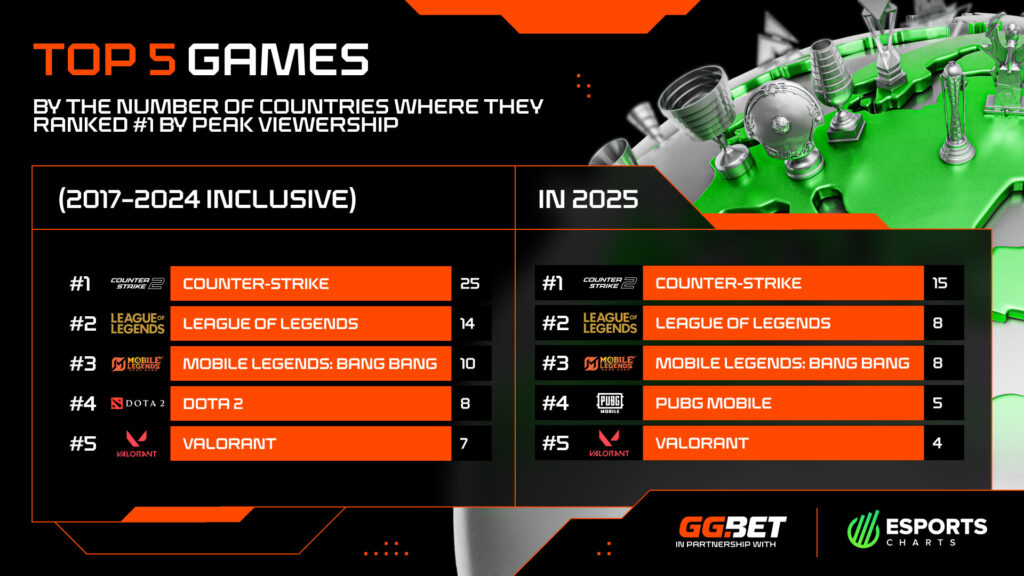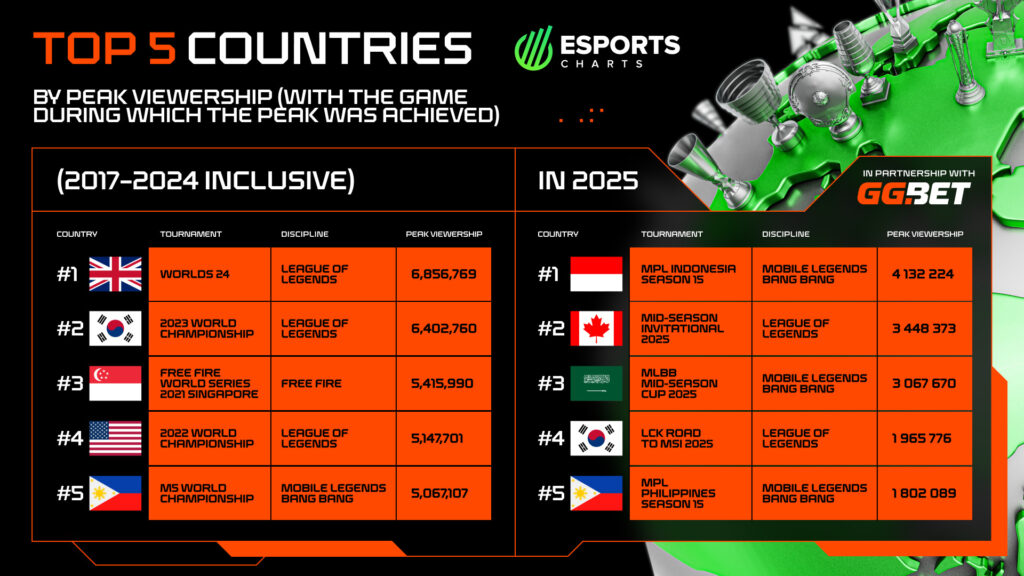Here is an in-depth analysis of esports trends worldwide, courtesy of Esports Charts’ Esports Map, powered by GG.BET.
It’s impossible to imagine the modern entertainment industry without esports. What began as a niche for gamers has grown into a global industry with complex infrastructure, a transfer market, millions of spectators around the world, and billions in revenue. According to data from esports stats providers, the global esports audience has increased by more than 200.5 million viewers over the last 5 years. Experts predict that the number of viewers around the world will exceed 640.8 million in 2025, with over half of those views coming from people who don’t follow esports or watch esports tournaments on a regular basis. The market growth rates are no less impressive: over the last few years, the global esports market has increased by at least 20% year-on-year. By the end of this year, the market is expected to reach 2.89 billion dollars, and exceed 7 billion dollars in 5 years.
The global esports ecosystem is huge and multi-faceted, and consumers engage with it in various ways and for various reasons: just for fun, for professional development, as a new direction for scaling business, and much more. For those wishing to dive deep into esports, top analytics service Esports Charts has joined forces with betting brand GG.BET to launch the Esports Map project, an interactive map showing the most popular tournaments in over 110 countries based on the number of peak viewers. The map currently spans 2017 to 2025, and in addition to providing the number of viewers for the most-viewed tournaments in a particular country, it provides easy access to various facts about the tournaments, like the winning team and prize amount, as well as historical data about breakthroughs from underdogs and unexpected losses from favorites. The map will continue to be updated, and new data, filters, and categories will be added.
Esports Map data isn’t just useful for people in the industry; it’s also great for brands that have only had brief contact with the esports industry, or have never been involved with it at all. Esports Map can help industry players formulate strategic plans for projects and events. For brands not involved in the industry, this interactive map can be an entry point into esports, where sponsorships and collaborations can increase a brand’s audience, facilitate an entry into new markets, and increase brand recognition.
Here, we’ll take a look at a few global trends and insights we can learn from Esports Map. All data on views and quantitative results have been provided by Esports Charts.
Counter-Strike continues to dominate
Despite the myth that Counter-Strike is losing popularity and falling behind more “modern” games, the data tells the opposite story. Between 2017 and 2025, CS tournaments have been the viewership leaders in 25 countries. In 2025 alone, they've been the most viewed in 15 countries. (Editor's note: This data refers to tournaments with the most peak views in a particular country, which does not always coincide with the game most popular with the local audience.) The expansive calendar of events covering different regions and such small breaks between tournaments gives Counter-Strike every chance to keep dominating viewership.
In countries where CS is the game with the most views for tournaments and matches, it is accompanied at the top by League of Legends and Mobile Legends: Bang Bang. League of Legends came second in 2017-2024, with top viewership in 14 countries, and third in 2025 (No. 1 in 8 countries). Mobile Legends: Bang Bang took third place in 2017-2024 (No. 1 game by peak viewers in 10 countries) and second in 2025 (No. 1 game in 8 countries). League of Legends and Valorant perform well in a number of countries, and in some places even take a share of the viewership away from CS, like in South Korea and Japan, where the competitive scene has shown strong growth. Mobile Legends: Bang Bang, which has historically been concentrated in Southeast Asia, is conquering new regions every year.

Bogdan Holovnov, Head of Esports at DATA.BET notes that Counter-Strike reigns supreme in betting among all games. ”51.84% of all our customers’ bets during the reporting period are placed on Counter-Strike. That’s no surprise, since the highest number of events and tournaments are held for this game every month. From a viewership perspective, though, the leaders are League of Legends and Mobile Legends: Bang Bang. Both are enormously widespread and incredibly popular in the Asia, and if there were an Audience Choice Award, it would go to LoL and MLBB. However, the fact remains that CS is number one when it comes to the amount of matches and tournaments, and there are no indications that it will lose that top spot any time soon.”
Does the popularity of a game in a certain region have any influence on the creation of an esports team? Evgeny Zolotarev, the CEO of NAVI, one of the most successful esports organizations, says popularity is an important factor, but the decision to create a team takes a whole range of criteria into account. Aside from tournament and match views, this decision is influenced by whether a player base exists, as well as its growth dynamics, financial conditions (salaries and transfers), any affiliate programs for clubs from the game publisher (revenue share, in-game digital items, etc.), and whether the game is featured in the Esports World Cup.
League of Legends Worlds is the most popular esports tournament
Three of the top five countries in terms of peak tournament viewership between 2017 and 2025 have hosted the League of Legends World Championship: the UK (Worlds 2024), South Korea (Worlds 2023), and the USA (Worlds 2022). The total number of peak viewers for all three tournaments exceeded 18.4 million, and last year’s World Championship set the record at 6,856,769 peak viewers. That record is likely to be surpassed in the Worlds 2025 this October, with China as the rating leader.
The popularity of the Worlds is a result of Riot Games’ comprehensive work on League of Legends. The game publisher has been criticized numerous times for the opacity of its ecosystem (ed. note: Unlike VALVE, Riot Games does not bring in tournament operators to hold their own tournaments and leagues), though Riot Games recently started actively supporting co-casting and alternative broadcasts alongside official streams, increasing their reach in various regions and their presence on multiple platforms at once. Despite some peculiarities and limitations, they managed to create their own game universe, setting the standards for the industry. Besides being portrayed in pop culture (comics, TV shows, music, etc.), Riot Games is invested in tournament viewership and isn't afraid to experiment. Beginning in 2014, each Worlds tournament has had its own soundtrack from a famous artist or band, and concerts and shows are put on for the tournaments’ finals. Riot Games was the first to create a virtual K-pop band made up of LoL characters, whose tracks garnered millions of views on YouTube and attracted new audiences. Collabs with Louis Vuitton, which produced the design of the Summoner's Cup trophy for the League of Legends World Championship, limited-edition in-game skins for League of Legends characters, and a line of real-life merchandise inspired by the game, broke the mold by combining high fashion and esports. These are all bold steps toward high brand recognition.

Mobile esports is catching up with the traditional sphere
A few years ago, mobile games like PUBG Mobile, Free Fire, and Mobile Legends: Bang Bang (MLBB) entered the esports arena, creating competition for legendary games and attracting an audience of many millions. The Free Fire World Series 2021 in Singapore drew 5,415,990 peak viewers, passing not just the MLBB M5 World Championship (at 5,067,107 peak viewers), but also the Worlds 2022 (at 5,147,701 peak viewers). In the first six months of 2025, regional Mobile Legends: Bang Bang leagues have overtaken League of Legends flagship events. Similarly, MPL Indonesia Season 15 drew 4,132,224 peak viewers, while the Canadian LoL Mid-Season Invitational 2025 came in at 3,448,373 peak viewers. Despite these successes, mobile esports on the whole can’t yet compete with the degree of dynamic growth of new audiences and entry into new markets seen in traditional esports. The most promising game in this category is still Mobile Legends: Bang Bang, which is showing growth and engagement in its global fan base.
Some mobile titles occasionally surpass even the biggest tournaments in traditional esports, which speaks to the strength and dedication of local audiences. However, mobile esports, like most traditional esports outside of League of Legends, remains concentrated in just a few regions, such as Southeast Asia, where mobile gaming culture is particularly strong, while interest in Europe and North America is much lower.
It’s also because the ecosystem is far less diverse: only a handful of mobile titles can sustain a long-term competitive scene, whereas PC and console esports offer a wide array of established disciplines, from CS and LoL to Dota 2 and Valorant.
In the end, it creates a paradox: while certain mobile events can generate massive peaks, it’s the broader ecosystem of the classic titles that continues to drive the growth of esports worldwide.
“The secret to the rapid development and popularity of mobile esports comes down to accessibility. To be a gamer, all you need is a phone. And unlike a good gaming PC, a phone is a much more accessible device. This accessibility generates mass appeal, which is undoubtedly a strength of mobile esports. That said, I don’t see any risk of mobile esports replacing traditional esports. I don't think PC disciplines will lose relevance any more than fighting and sports simulator games on traditional consoles. They’re parallel directions that don't interfere with each other. In fact, the opposite is true: they have a common desire for an entertaining competitive element,” said Evgeny Zolotarev, NAVI CEO.
Tournament series loyalty
Year after year, tournament operators continue to improve their tournament series. They have a well-known style, frequency, and fan audience, which practically always puts them among the leaders in terms of viewership. In the first half of 2025, local LoL events and the BLAST, MPL, Intel Extreme Masters, and PUBG Mobile Super League tournament series occupied the top slots by peak viewers in the host country.
In 2024, GG.BET partnered with the whole CS2 BLAST tournament series. That tournament year, we launched a complex promo campaign, which has evolved from season to season. We also implemented a series of offline and online activities, both for users of our platform and for CS fans watching matches from different parts of the world and visiting arenas. As a result, we captured 184.8 million viewers on streams alone. This instance of long-term partnership between an international betting brand and a tournament operator is one example of how productive cooperation drives the industry itself, increases recognition for both brands, and can become the precedent for new and exciting collaborations.
For more interesting statistics and unexpected esports information, check out the Esports Map website. The interactive map is available on the Esports Charts website at https://escharts.com/esports-map